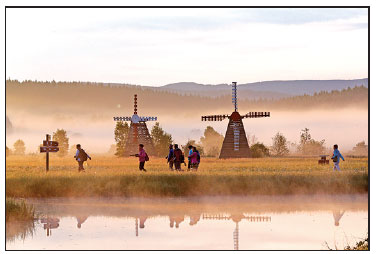Story behind Saihanba's transformation to be told in upcoming TV series
By Xu Fan (China Daily) Updated: 2017-09-08 09:51When Guo Jingyu traveled to the Saihanba National Forest Park for the first time, he was a teenager. And his only memory of the park was the vast grassland.
But many years later, in 2015, Guo, then a TV producer and director, learned more about the area, which is located in Hebei province and borders the Inner Mongolia autonomous region.
Zhou Zhongming, Party secretary of Chengde, Hebei province, told Guo about those who had devoted their entire lives to reviving the area.
The conversation sparked Guo's interest and paved the way for the TV series Zuimei de Qingchun (Most Beautiful Youth).
In the Great Hall of the People in Beijing last week, Guo alongside the cast and crew wore black T-shirts with the drama's name to promote the 40-episode series, which began filming on Sept 5 in Saihanba. The filming is expected to take around five months.
The story starts in 1962 with 127 college or vocational school graduates joining 242 employees in the local forest farm.
Saihanba was a popular hunting ground for northern China's rulers in the 10th century, and for emperors of the Qing Dynasty (1644-1911).
But the area's natural environment deteriorated because of unlimited logging.
In the early 1950s, Saihanba was no more an oasis, but barren land. And it became a passage for sand blowing into Beijing from the deserts in Inner Mongolia.
Estimates then said that the sand would bury the Chinese capital within decades if the situation continued.
So, China decided to protect the capital from the sand.
The Saihanba project, which now covers a total area of 92,000 hectares, is perhaps the world's largest man-made forest.
Guo says that after interviewing more than 120 people - from planters to local officials - who have been involved in the project, he was both shocked and touched.
"The temperature in Saihanba falls to-40 C and the living conditions are very harsh," he says.
The first batch of young graduates, then in their 20s, mostly forestry majors, had to be innovative to fulfill their mission.
"On some craggy hills that were covered by just 2 meters of soil, not enough for growing trees, they dug holes in the hard ground with their bare hands to plant the saplings that they carried onto the slopes," says Guo.
"The young people devoted their best years to making Saihanba green again. It's a spirit worthy of respect," he adds.
"I am not sure that such a theme will appeal to young audiences, but I believe that such a series needs to be made to pass on this spirit to the younger generations," he says. The TV series stars Liu Zhiyang, He Yuhong, Gao Ming, Jia Hongwei, Zhao Huanxuan and Yu Hongzhou.
Ju Xingmao, the director, says two large sets have been built in Saihanba, and the crew purchased some trucks that were in use in the 1960s. "We'll try to relive the story," says Ju.
xufan@chinadaily.com.cn
|
Saihanba becomes green again after decades of hard work by people involved in turning a desert area into a forest.Zou Hong / China Daily |
- 'Cooperation is complementary'
- Worldwide manhunt nets 50th fugitive
- China-Japan meet seeks cooperation
- Agency ensuring natural gas supply
- Global manhunt sees China catch its 50th fugitive
- Call for 'Red Boat Spirit' a noble goal, official says
- China 'open to world' of foreign talent
- Free trade studies agreed on as Li meets with Canadian PM Trudeau
- Emojis on austerity rules from top anti-graft authority go viral
- Xi: All aboard internet express












